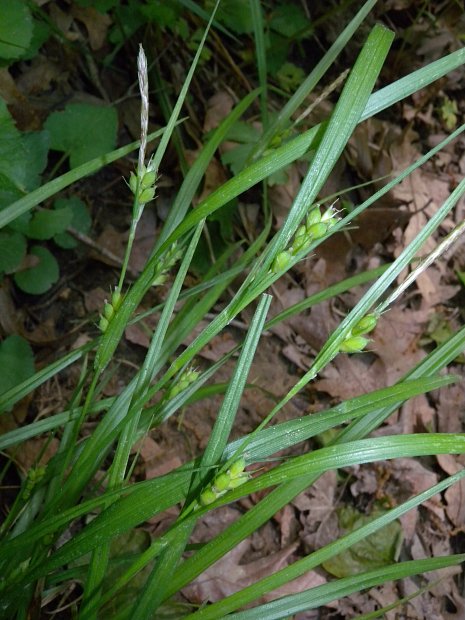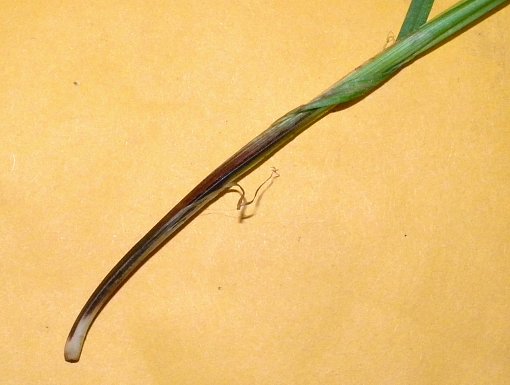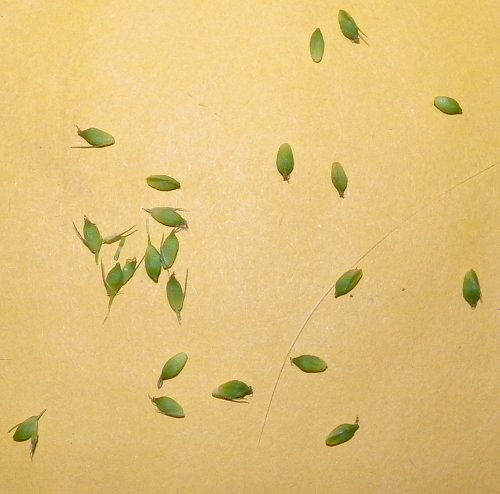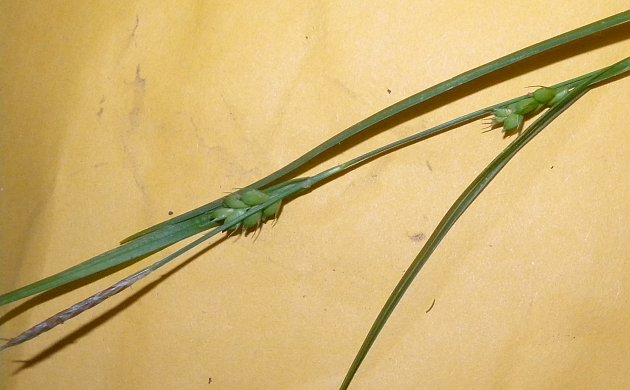
The pistillate spikelets are up to 15 mm. long and 4-5 mm. across; they are erect or ascending (relative to the rachis) on stiff peduncles up to 12 mm. (½") long. The peduncles become shorter as they ascend the rachis (central stalk) of the inflorescence; the uppermost pistillate spikelet is nearly sessile. The slender staminate spikelet of each inflorescence is 13-25 mm. long and its peduncle is variable in length (3-25 mm. long). Each pistillate spikelet has 2-8 loosely arranged perigynia and their scales; these perigynia are ascending and they are slightly to moderately overlapping. Individual perigynia are 4–4.5 mm. long and 2 mm. across; they are oblanceoloid-ellipsoid and bluntly 3-angled in shape, tapering into short straight beaks. The perigynia have fine vertical veins along their sides and they are glabrous; immature perigynia are light green, while mature perigynia become yellowish brown. The pistillate scales of the perigynia are ovate-shaped at their bases, abruptly tapering into slender awn-like tips; they are green-veined in the middle and membranous along their margins. The pistillate scales are as long as, or slightly longer than, their perigynia (4-5 mm. in length). The blooming period occurs during late spring, lasting about 1-2 weeks. The florets of the spikelets are cross-pollinated by the wind. The achenes of mature perigynia are 2–2.5 mm. long, glabrous, obovoid-ellipsoid, and bluntly 3-angled in shape. The root system is fibrous and short-rhizomatous.

Cultivation: The preference is partial sun to medium shade, more or less mesic conditions, and loamy soil with decaying organic material.
Range & Habitat: The native Sparse-fruited Sedge occurs in widely scattered areas of Illinois, where it is uncommon to occasional (see Distribution Map). Habitats include rich deciduous woodlands that are more or less mesic, wooded slopes above streams, and wooded slopes along limestone bluffs. The dominant canopy trees in such habitats are usually Sugar Maple (Acer saccharum), American Beech (Fagus grandifolia), or American Basswood (Tilia americana). Less often, Sparse-fruited Sedge may occur in savannas, mesic prairies, and the lower slopes of hill prairies. This sedge occurs in average to high quality natural areas.

Faunal Associations: Caterpillars of a butterfly, the Appalachian Brown (Satyrodes appalachia), feed on the foliage of sedges (Carex spp.) in woodlands. The larvae of various microlepidoptera, especially leaf-mining moths, feed on these plants. These species include Elachista argentosa, Elachista cucullata, Elachista madarella, and Clemens' Cosmopterix Moth (Cosmopterix clemensella). Other insect feeders include the stink bug, Mormidea lugens, and such aphids as Carolinaia caricis, Iziphya flabella, and Prociphilus corrugatans. Among vertebrate animals, the seeds are eaten by the Bobwhite Quail, Wild Turkey, Eastern Towhee, and various sparrows. When woodland sedges are abundant, they provide protective cover for small rodents, ground-nesting woodland birds, and other wildlife.
Photographic Location: A mesic deciduous woodland in Macon County, Illinois.

Comments: Sparse-fruited Sedge (Carex oligocarpa) is one of many woodland sedges in Illinois. This sedge resembles Wood Gray Sedge (Carex grisea), except it has more narrow leaves, reddish or purplish basal sheaths, fewer perigynia in its pistillate spikelets, perigynia that are bluntly 3-angled rather than terete, perigynia with short straight beaks rather than beakless, and a staminate spikelet that is sometimes conspicuously exserted above the uppermost pistillate spikelet. Sparse-fruited Sedge also resembles Hitchcock's Sedge (Carex hitchcockiana), but this latter species has finely pubescent sheaths rather than glabrous sheaths and its perigynia have curved beaks, rather than straight beaks. Recently, a new sedge has been described that closely resembles Sparse-fruited Sedge. This new species, Flat-spiked Sedge (Carex planispicata), can be distinguished by its wider leaves (up to 6.5 mm. across), more abundant perigynia in its spikelets (5-14), and slightly longer perigynia (4.5–5 mm. in length). Because both of these sedges can be found in similar habitats, there exists the possibility that they may hybridize and intergrade, making identification of field specimens difficult. Other common names of Carex oligocarpa are Few-fruited Sedge and Rich Woods Sedge.